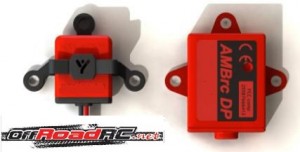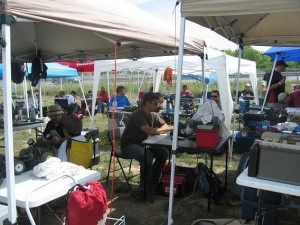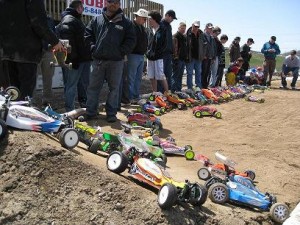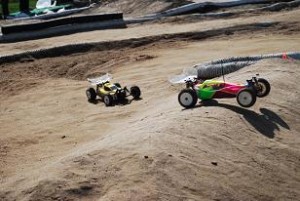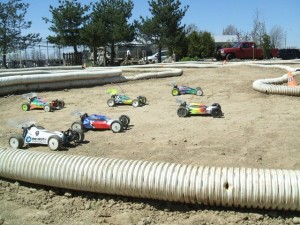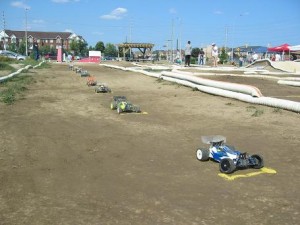- Have any questions?
Racing at Sids
Items to bring to the race
- Pit Table
- Chair
- Extension Cord
- Sun Tan Lotion / Sun Glasses
- Running shoes are preferred
- Obviously your RC vehicle and tools along with some spares
- The right tires for the track (click here for recommended tire choices)
- Pop Up Tent (optional)
An R/C race is monitored by a computer and transponder system much like Formula 1 style racing! Every car has a transponder mounted inside which triggers the computer lap timing software each time the car crosses the sensor or ‘loop’. The transponder loop is buried under the track and marked with a spray paint lines. You can purchase your own ‘personal transponder’ from most hobby shops. The transponder that we use this year for racing is the AMB Personal Transponder. Every transponder has a unique number, no two are identical. Sid’s uses the AMB RC3 decoder which is what most RC tracks in Ontario use. All AMBrc PT transponders and RC4 hybrid transponders (2-wire) and MRT PTX will work at Sid’s raceway. (see pic on the side). The AMB RC4 3-wire transponder WILL NOT WORK, as it was designed only for RC4 decoders.
When you first arrive at the track unload your gear at the designated drop off area. Once that is done, move your car to the designated parking which we have reserved on Parkgate Drive. You cannot park on the lawn in front of the fence at Sid’s Pond and Gardens. We expect a higher number of entries this year, so in anticipation of this; we have obtained a blanket permit by the city of Mississauga so your car will not be ticketed for parking on the street. However, even with the blanket permit – you must still obey proper city by-laws. You cannot block any residential driveways, nor park within 3m of a fire hydrant, or within 5m from an intersection. Arrive early to unload your gear, get your pit spot and setup your table and equipment, then park your car at the designated area.
You should have all your equipment setup, and batteries charged even before open practice begins.
Make sure you listen to when the classes are called up for practice. We generally split the buggies and short course trucks into separate practice sessions, and 10 min heats with a max of 10 drivers on the stand at one time.
It is best to take it easy on the first couple of laps and get familiarized with the layout. Keep note of any of the featured jumps on the track. Try not to drive too aggressively in practice as grip is lower in the morning and the track is still moist and cold.
Normally before we start the qualifying, we will ask all drivers to line up by the drivers stand their vehicles to do a group photo shot.
While everyone is still gathered there, we also run thru a quick review of the rules; as well as announcements and thanks to the sponsors who supported our series.
The first round starting order is either a random computer selected order, or we will draw for a starting grid order within your heat. Qualifying rounds are races versus time which is 5 minutes long. If you do not have a Personal transponder it’s best to ask the race director 2 min before your qualification “heat” starts so you can borrow one. Each group is called a heat, where 8-10 drivers race against the clock around the track. When your heat is up you must put your car on the track and drive past the transponder loop. If your transponder is functioning you will hear a sound from the computer system confirming your transponder is working. Feel free to do a few test laps until the race director confirms everyone is “checked in” and the qualification heat can start.
Each car lines up before the loop in a spread out fashion. When the race director calls your name you can start your qualifier.
Example: “Glenn, << 2 second pause >>, Craig, <> “ wait for your turn then get going!
Although there are multiple cars on the track, each car is on their own clock timer. When your qualifier has completed the results will be printed. Depending on the number of racers in your class (Ex: 2wd Buggy) there will be multiple qualifying groups or “heats.” If there are three groups of 2wd Buggies, it’s not until all three groups have run that the “round” for 2wd Buggy is complete. After the last heat you can see how your time compares to the rest in this round.
After you have finished your qualifier you must Marshal the next qualifier. Marshaling involves standing at a designated spot on the track and flipping cars over which have crashed. You must marshal after your race or risk being disqualified.
Resort of the heats after the round is complete.
After the round is completed, there will be a resort. Depending how you finished in the previous round, you will be starting in that order for the next round. Please check the posted print outs after each round, as chances are that may not be starting in the same heat or group of drivers from the previous rounds.
NOTE: One important racer’s tip, when qualifying, if another racer gets very close behind you and is with you for a few turns it’s customary to let that driver pass since they are going faster than you. Slow down just for a brief second while they pass and then try to keep up.
The typical order of the rounds are: 2wd Buggy, 2wd SCT, 2wd Stadium, 4wd Buggy, 4wd SCT
The Mains are the highlight of the race day, where the real racing action begins. Normally there are 8 to 10 drivers per main. Your starting position and which main you start in will depend on your best 2 out of 3 qualification times. Unlike qualifiers where you line up before the loop. For the mains you will be placed on the straight away in the order you qualified. For example if you qualified 3rd from the top, you will be starting in third place on the starting-grid in the A-Main. If you qualified 13th for example you will be starting in the B-Main in 2nd or 3rd spot.
When the race director sees all the cars are checked in and ready, the typical starting call is “Drivers ready, marshals ready, starting in less than 5….” Then the “GO” Tone will sound and all drivers are to start at the same time! At this point race time is not important it’s your position among the rest that counts. Take it very easy the first few turns and try not to crash early. The race is never won in the first turn!
We normally run the lower mains first, and on occasion, we will allow bump up positions for the next higher mains, leading up to the A-Mains, which runs at the end of the day being the fastest 8-10 drivers of the class. If you win your main, you have the option to bump to the last position in the next higher main. Your choice. Race times in the Mains vary depending on which Main you are in. A-Mains are now 10 minutes, B Mains 8 minutes (Times can vary per race/event as well)… After your main you will Marshall the next race.

